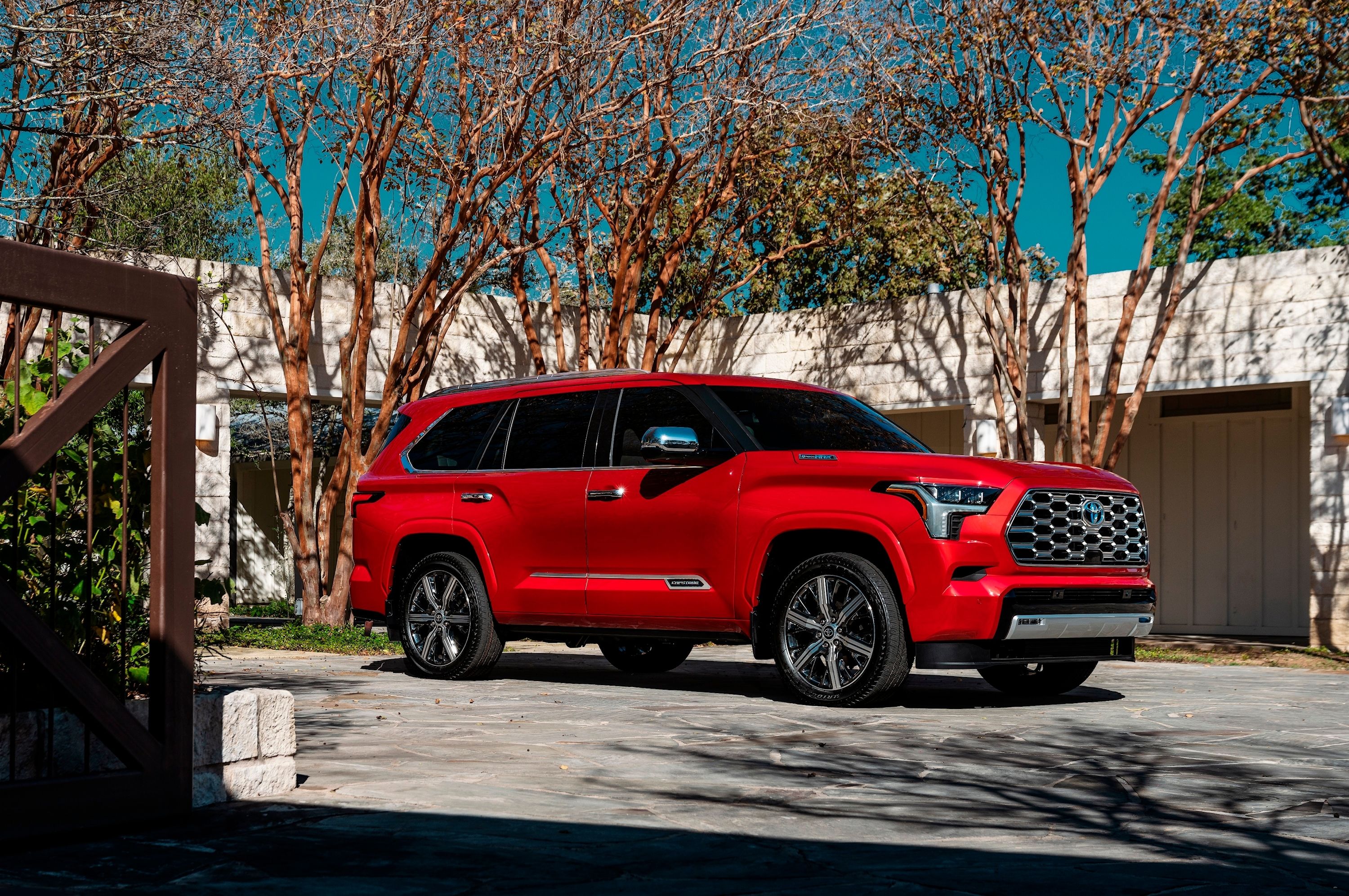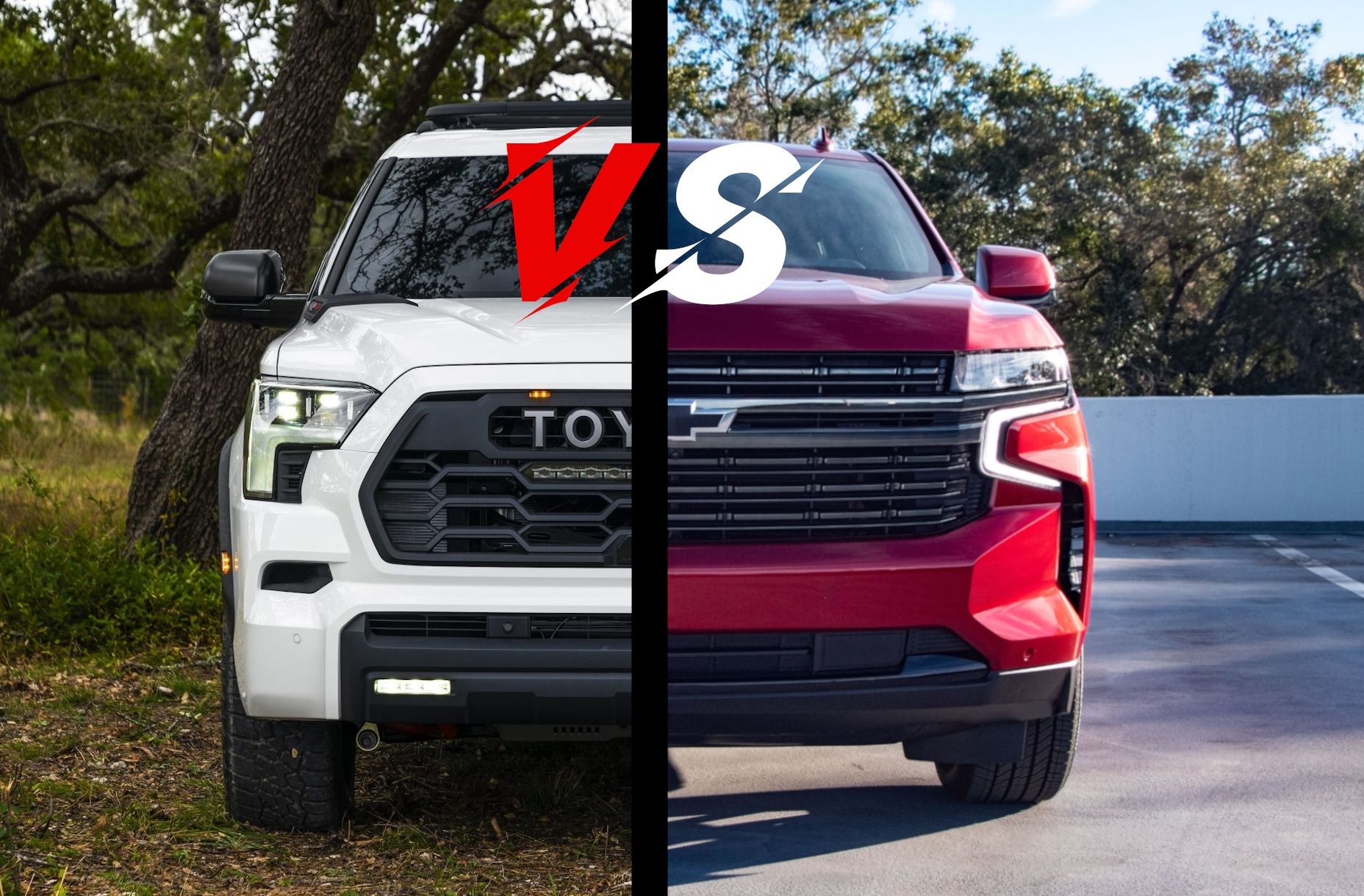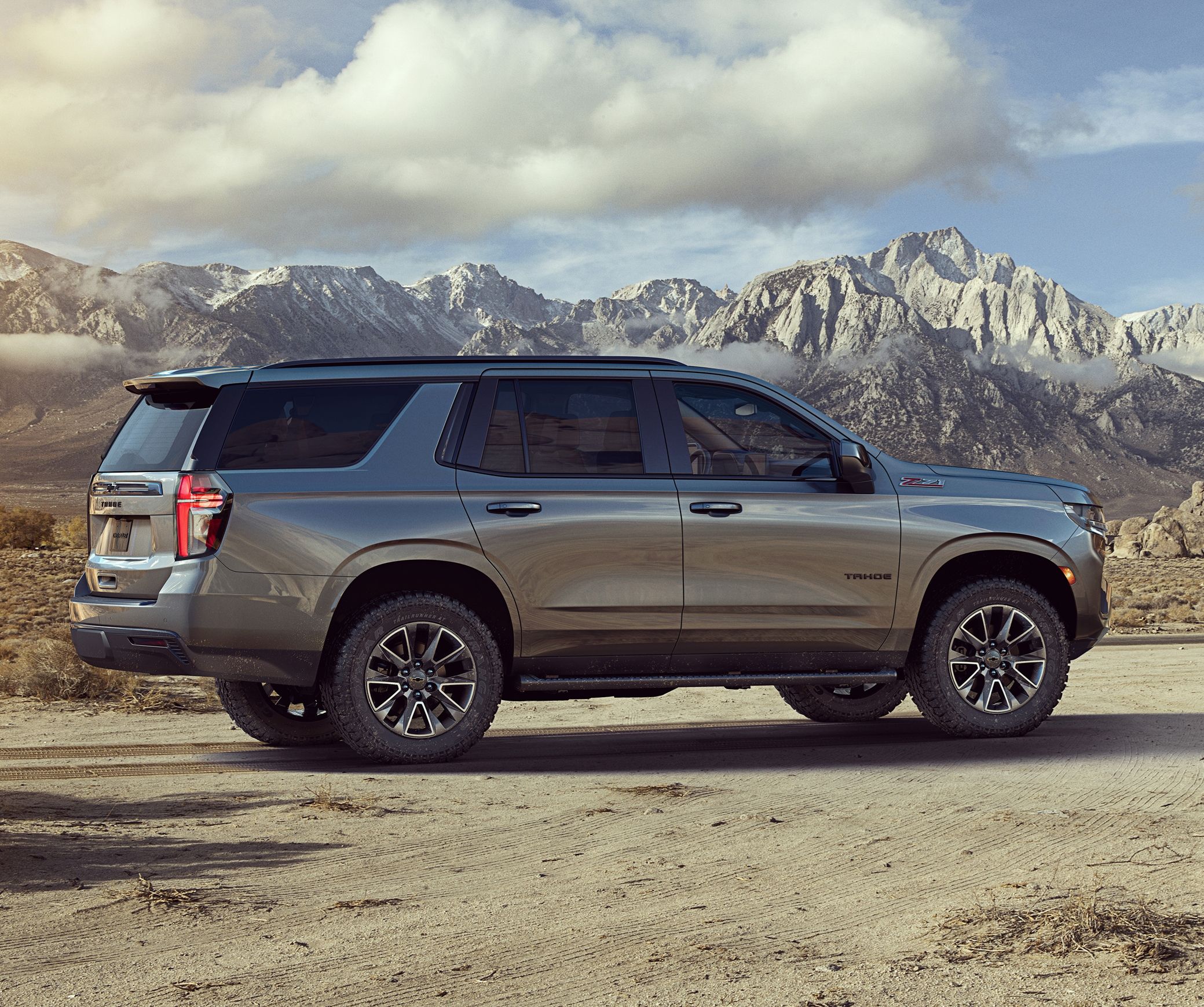
After being on sale for one millennium, Toyota finally decided to replace the three-row Sequoia for 2023.
When it arrives in the summer, it will boast an all-new twin-turbo 3.5-liter V6 engine with hybrid assistance borrowed straight from the Tundra. Looking at the exterior and interior, you have to wonder whether America actually needs the new Land Cruiser.
Some things are being kept as is, however. The all-new Sequoia still uses a body-on-frame chassis with an all-around independent suspension system.
One of its closest rivals is the Chevrolet Tahoe, which has always been a staple in the US market. Unlike the new Toyota Sequoia, the Chevy still relies on two old-school V8 engines and one optional diesel powertrain. The rest of the Tahoe is essentially new, as it was introduced a little more than a year ago.
How do these two three-row SUVs stack up against each other?
Exterior Design: Would You Like Some Car With That Grille?
The Sequoia and Tahoe follow the same basic modern SUV recipe. You take one oversized grille, add some eye-grabbing headlights, and the front-end is sorted. The Tahoe's front-end looks a bit more elegant thanks to the slimmer headlights and less ostentatious grille, while the Sequoia oozes aggression.
You can see the same muscular design on the Toyota's side profile. While Chevy decided to keep things slab-sided, Toyota included pronounced, muscular wheel arches.
At the rear, both SUVs are boxy to provide the maximum amount of space. Once again, Chevy's design is more elegant, while the Toyota is more in-your-face.
Thankfully, the new Sequoia still carries its name on the back, but now it's in big, bold letters. If nothing else, we'll now have a helpful rolling reminder of the right way to spell Seqoiuowaioa.
Both SUVs offer various exterior styling cues. Base Tahoe models get LED headlights and 18-inch wheels. Upper trim levels have 20 to 22-inch alloy wheels. These are less practical for off-roading, but they look good.
Toyota's wheel selections are more practical but no less striking. The off-road-biased TRD Pro gets 18-inch model-specific alloys that leave more space for high-profile reinforced tires. The rest of the range receives 18 to 20-inch alloys, while the new upmarket Capstone trim gets 22-inch chrome wheels.
Interior Design: Toyota Takes A Giant Leap Forward
The previous-generation Sequoia's interior was a mixed bag. It was spacious and comfortable but entirely ruined by a horribly outdated center console. The old layout was an ergonomic nightmare. It looks like two completely different interiors were smashed together, or Toyota's designers simply didn't know what to do with all that extra space.
The new interior is carried over from the Tundra, which is good. Material quality is in a different league, and the layout of the primary controls is sublime.
You'll notice the new touchscreen interface with the latest connectivity features, but Toyota was also wise enough to keep the climate control buttons separate. The only oddity is the USB charging point, which is located next to the climate control and not in the small storage space underneath the center console. The Capstone luxury trim also boasts modern features like wireless charging, a digital instrument cluster, and a high-end sound system.
Compared to the Toyota, the Chevrolet's interior already looks outdated. Chevrolet freed up some space by removing the shifter, but the placement of the gear buttons on the center console is awkward. The touchscreen interface also looks like an afterthought, though we appreciate the separate buttons for the music player and climate control. Disappointingly, Chevy also missed the opportunity to mimic the Cadillac Escalade's massive curved-screen infotainment setup
Chevy also uses more hard plastic, even on top-trim models. Top-spec models get a large 15-inch head-up display, which is a joy to use. Once you learn the layout of the steering wheel buttons, you never have to take your eyes off the road again.
Powertrains: Modern Vs. Old-School
The previous-generation Sequoia used a naturally-aspirated 5.7-liter V8 engine, well-known for being robust and reliable. It produced 382 horsepower and 401 lb-ft of torque and was mated to an equally reliable six-speed automatic transmission. Toyota's new twin-turbo 3.5-liter hybrid V6 produces 437 hp and 583 lb-ft of torque, representing massive gains in the power department. Due to the nature of a turbocharged engine, the power is also delivered much lower down in the rev range. The all-new ten-speed transmission also allows the Sequoia to get the most out of the engine.
As a result, the car accelerates harder, yet it's more fuel-efficient. The power gain also means the new Sequoia can tow 9,000 lbs, a 22% increase over the older engine.
The Sequoia's EPA-estimated gas mileage figures aren't available yet, but we can glance over at the Tundra's claimed figures. With the hybrid powertrain, the pickup can manage 19/22/21 mpg city/highway/combined. We expect the Sequoia to closely match this.
While this engine has yet to prove that it's a reliable powertrain, we doubt Toyota would have used it if it wasn't.
Chevrolet kept things more traditional with the Tahoe. It has three engine options, and all are mated to a ten-speed automatic transmission. The standard is a naturally aspirated 5.3-liter V8. It produces 355 hp and 383 lb-ft of torque, which is way below the Sequoia's authoritative figures. Still, this old mule can tow up to 8,400 lbs.
You can upgrade to the 6.2-liter naturally aspirated V8, producing 420 hp and 460 lb-ft if you want more power. Those who value fuel efficiency and low-down torque can also go the diesel route with the 3.0-liter Duramax turbocharged diesel. It only provides 277 hp and 460 lb-ft of torque from just above idle, and tows up to 8,200 lbs.
Compared to the Sequoia, the Tahoe's gas engines are thirsty, managing best figures of 15/20/17 mpg, although the diesel mill is great at 21/28/24 mpg.
While the Sequoia's engine is a modern masterpiece, Chevrolet scores some points for offering a wider selection of powertrains.
Interior Space: Room For A Big Family
Toyota has not released headroom and legroom figures yet, but we had the opportunity to clamber around in the new model earlier this year. The front and second-row offer vast amounts of space, even more so when you go for the optional second-row captain's chairs.
The second-row chairs fold forward reasonably easily, allowing access to a third row that's large enough to accommodate two adults or three kids. Toyota claims an industry-first sliding third row, allowing you to increase the legroom with six inches of adjustment. It works very well, but it impacts the cargo capacity.
With all the seats folded, the Toyota offers less cargo capacity than the Tahoe, although an exact figure hasn't been released . The load floor also isn't flat, as the batteries are mounted under the floor behind the rearmost seats.
The Tahoe is available in the same configurations. You can have an eight-seater with second and third-row benches or a seven-seater with second-row captain's chairs.
Chevy doesn't have fancy sliding third-row seats, but it makes up for it by providing ample headroom and legroom. You might not be able to fit three adults side-by-side, but the 35 inches of legroom is suitable enough for short trips.
With all three rows in place, the Chevy still has 25.5 cubic feet of cargo capacity to work with. That means you can do the weekly grocery shopping without having to put the seats down. When you fold all the seats down, you get a full 123 cubes to work with.
Technology: Driver Assistance And Much More
The Tahoe's engines may be pragmatic, but Chevy offers a few modern tech features.
On the ride and handling side, the RST trim comes with Premium Smooth Ride Suspension adaptive suspension. All models get tri-zone climate control and a touchscreen interface, while the top-trim boasts an HD surround-view camera system and a 15-inch head-up display.
Since these SUVs are essentially high-riding minivans, safety is paramount. That's why we're disappointed with the lack of standard driver assistance features.
Base models only get automatic emergency braking, forward collision alert, auto high beams, front and rear parking sensors, lane-keep assist, and all traditional active and passive safety features.
All Sequoias come standard with forward collision assist with pedestrian and cyclist detection, emergency steering assist, adaptive cruise control, lane-keep assist, traffic sign recognition, rear cross-traffic alert, blind-spot monitoring, and front and rear parking aids. That's mighty impressive.
Other nice features include the optional 14-inch touchscreen interface with wireless Apple CarPlay and Android Auto, wireless charging, over-the-air updates, and a split-view monitor that allows you to see what's happening on either side of whatever you happen to be towing.
Off-Road: Dedicated Models In Both Ranges
Chevrolet and Toyota both offer an off-road-oriented model. The Z71 Tahoe is Chevy's offering, and it comes standard with a two-speed transfer case with low-range, 20-inch wheels with all-terrain tires, a locking rear differential, and underbody protection.
It looks the part and is capable of more than most full-size SUVs, but it's not the kind of 4x4 you'd want to take on a trail. Those 20-inch rims may look good, but ideally, you want a smaller wheel with more space for a bigger tire with a reinforced profile.
That's exactly what Toyota gives you with the TRD Pro.
It has the same size wheel as the entry-level model, but you get a model-specific alloy. Crucially, this allows for more off-road friendly tires to be fitted to the Sequoia.
The TRD is available exclusively in 4WD with low range and a locking rear differential. Toyota takes it further by including a model-specific suspension setup that includes Fox internal bypass shocks as part of the multi-link coil setup.
Toyota also includes additional underbody protection and a few fancy electronic aids like Terrain Select, Crawl Control, and Downhill Assist. You can also remove the anti-roll bar manually to increase wheel articulation.
Verdict: It Depends On Cost
The Tahoe is a respected product because it's an honest SUV that does exactly what it says on the box. Prices start at roughly $50,000 and go up to $74,000, giving customers a wide variety of trims and configurations to choose from. Whatever purpose you have in mind, there's a Tahoe fit for the task.
The pricing for the new Sequoia is not available yet, but the previous model also retailed from roughly $50,000 to $70,000. Given the substantial upgrades to the engine and interior, it's unlikely the price will be the same. Now that the Land Cruiser is dead (at least in the USA), the Sequoia is Toyota's new halo SUV. Will the pricing reflect that?
If the Sequoia is in the same price bracket as the Tahoe, it wins this comparison quite easily. The Tahoe is a great all-rounder, but the new Sequoia moves the goalpost in every category that matters.


